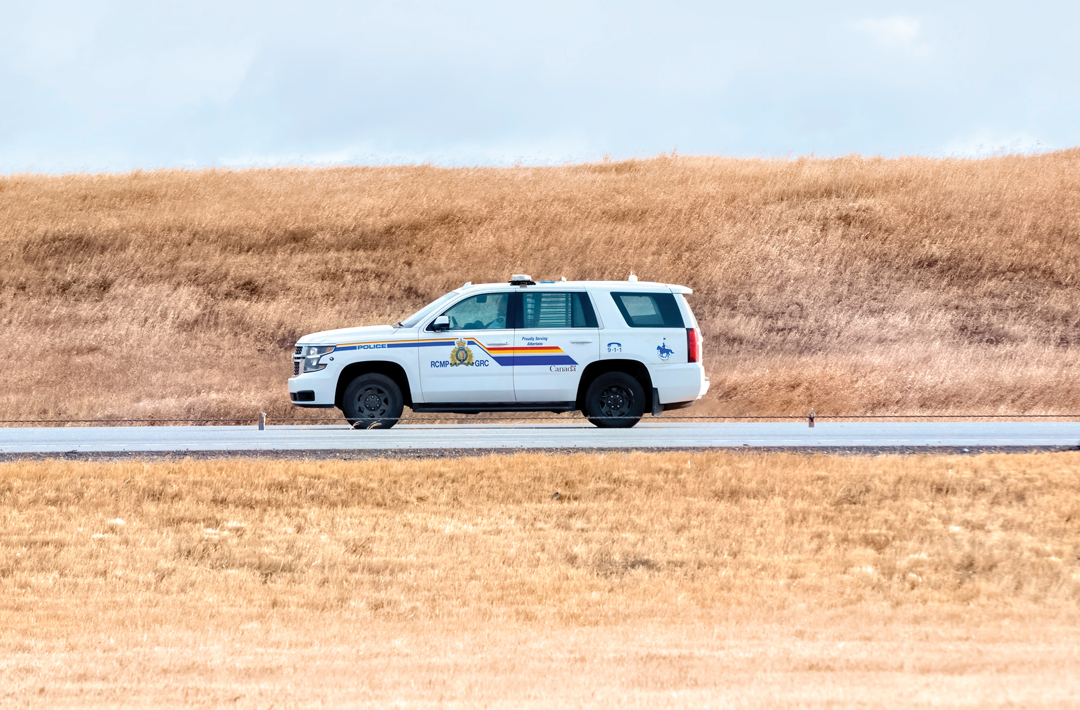INTRUDER ALERT
BY GEOFF GEDDES • PHOTO: SHUTTERSTOCK
Farm intruders can steal and damage vehicles and equipment, enter homes and rattle peace of mind. In response, the RCMP has upped its crime-fighting game with data-driven strategies, new programs and crime awareness initiatives.
REEL THEM IN
“Ninety-five per cent of our crime is caused by five per cent of the population,” said Troy Savinkoff, corporal and public information officer with the Alberta RCMP Media Group. Over the last several years, the police have developed Crime Reduction, a program that involves “intelligence-led policing.” Rather than simply conduct patrols to intercept thieves, officers use crime data to predict where criminals are likely to strike. “Let’s say we’ve had several vehicles broken into on Highway 1 near the Petro-Canada at the Highway 22 intersection,” said Savinkoff. “We can put a bait vehicle there and make an arrest when someone takes the bait.” Such vehicles can be remotely monitored through GPS tracking and may even contain a kill switch to turn off the engine remotely and lock the driver inside.
As part of this proactive approach, every call the RCMP takes is documented, and analysts regularly review the data. Once they identify the worst offenders, officers will either pay them a visit to discourage their actions or place them under surveillance. If this sounds like a Charter of Rights and Freedoms violation in the making, there is more to the story. “We’re not randomly targeting these people,” said Savinkoff. “They are prolific offenders that are harassing the public on a regular basis. It’s amazing how much crime a few offenders can commit. For those individuals, it’s pretty much their full-time job. If you remove them from the equation, even temporarily, it can have a major impact.” The police also raise awareness of rural crime through social media and community presentations.
HELP US HELP YOU
Savinkoff noted the RCMP polices 660,000 square kilometres in Alberta, a massive responsibility. This naturally makes public assistance essential. “The public is our most powerful tool, so we encourage people to report suspicious activities. If it’s not an emergency, you can call your local detachment, but always use 911 when it’s urgent.” Public input generates data the RCMP can act upon. “The better we understand what is happening across Alberta, the more effectively we can deploy our resources where they’re needed most.”
While high-tech is a big part of policing, Savinkoff offers low-tech advice for farmers: Trust your instinct. “Often you will have an innocent-looking person knock on the door to check if anyone is home,” said Savinkoff. “If it feels wrong, send them politely on their way and call us immediately so we can respond while they are still in the area.”
Police discourage private citizens from acting on their own when they witness a crime in progress. “I have seen farmers try to block someone who is stealing their truck, and they end up getting rammed or shot at,” said Savinkoff. “It’s just not worth it.”
THE UNWELCOME MAT
To deter crime, view your property from a thief’s perspective. “What makes your property a target? Why would they pull into your driveway and not someone else’s?” said Savinkoff. “Avoid placing an outbuilding or shop in the middle of nowhere, and use fencing, cameras, lighting and/or dogs as a deterrent.”
To augment RCMP efforts, the Government of Alberta recently earmarked $4.3 million to boost surveillance by Alberta Sheriffs. The money funds two plainclothes officer units that work to reduce crime in rural areas. “Addressing rural crime is a top priority for our government,” said Arthur Green, press secretary for Alberta Public Safety and Emergency Services. “Every community has a right to feel safe, no matter where they are in the province.” Sheriffs’ surveillance teams gather intelligence on suspected offenders and obtain evidence for court charges.
As well, the Province is aiding rural communities in the face of a 39 per cent increase in policing costs due to a recent RCMP collective agreement. For the next year, the government will cover the increase while discussing future policing needs with rural centres.
GET THE TRUCK OUT OF HERE
Curbing theft is also top of mind for Brent Christensen, a former Alberta Grains Region 4 director. His farm east of Holden has been the target of multiple crimes. We’ve had three vehicle thefts and a home break-in over the last seven years,” said Christensen. “One theft happened while I was sitting in the house having breakfast. With all three, the thief crashed the truck, and it was a total write-off.” In the home break-in, the culprits kicked in the door while the Christensens were away and stole several items. They also took a three-quarter-ton diesel truck from the yard.
“The truck thefts were annoying, but the house break-and-enter was an invasion of our space, and that is hard to get over,” said Christensen. While being targeted was traumatic, the RCMP response was heartening. “The officers got here very quickly on each occasion and did all they could,” said Christensen. “After the home incident, they checked the whole house and made sure it was safe for us to return.”
The couple installed a security system with surveillance cameras that can be checked on their smartphones. They are careful to not leave valuables in plain sight when they’re away. They advise others to use similar systems, to be mindful of their surroundings and report anything that looks out of place.
Though he realizes the RCMP has limited resources and does the best it can, Christensen would like to see the justice system get tougher on repeat offenders. “With most thieves, it’s catch-and-release,” he said. “They’re let go the next day with an order to appear, which they may or may not obey.”
Still, Savinkoff is proud of the progress the RCMP has made to address rural crime. “Compared to five years ago, we are seeing a nine per cent decrease in break-and-enters, and theft of motor vehicles is down 10 per cent. Also, in spite of having to cover a lot of ground, our average response time is 21.2 minutes.
“Our approach today is effective policing, and it’s what we in law enforcement love to do,” said Savinkoff. “As police officers, we protect the public from harm. It is fun to deploy these assets and catch the criminals.”
Most importantly, farmers must stay vigilant and report crime and suspicious sightings. In doing so, they provide the data that fuels RCMP policing efforts.







Comments